
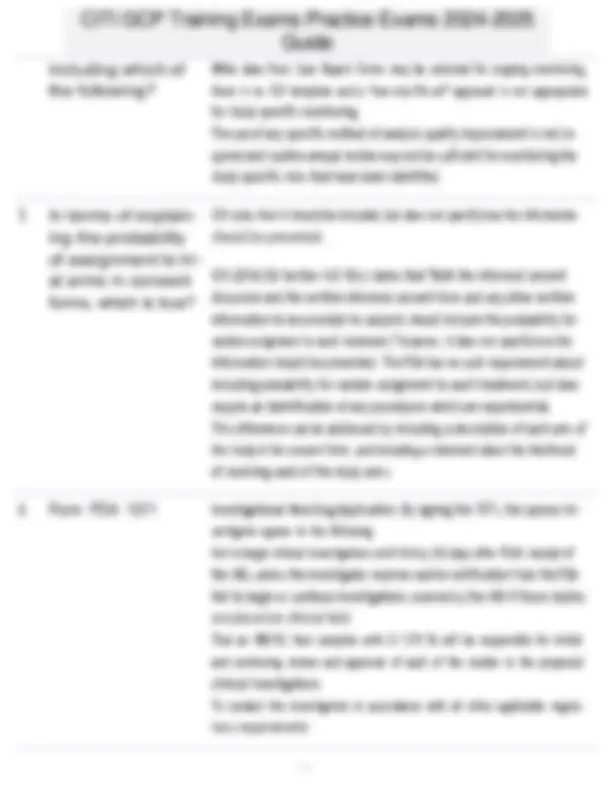
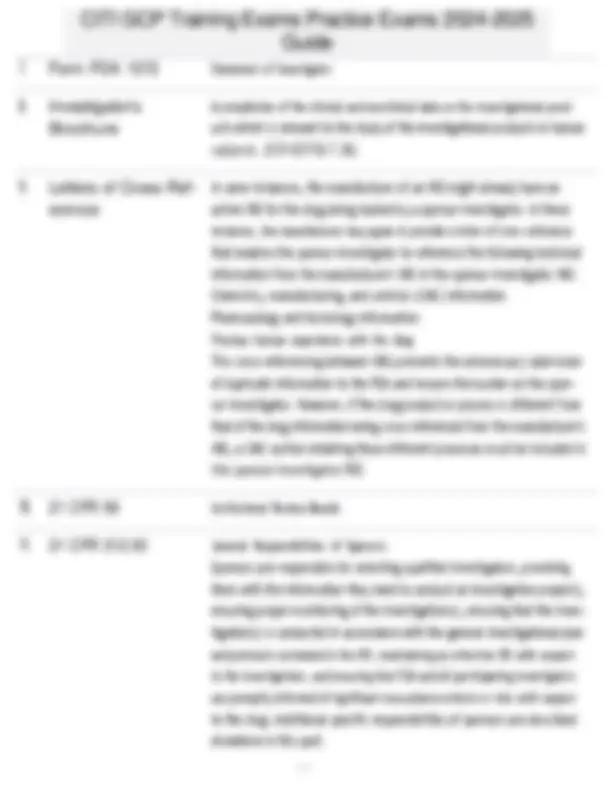
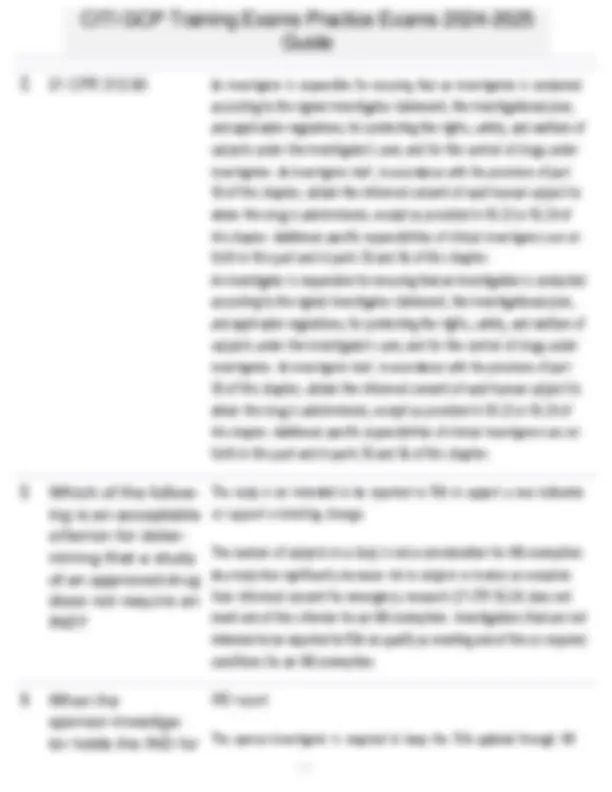
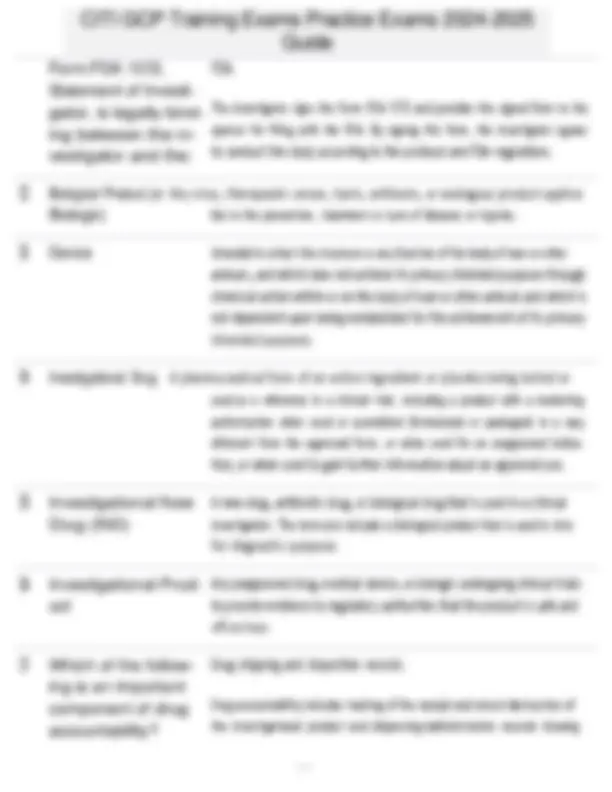

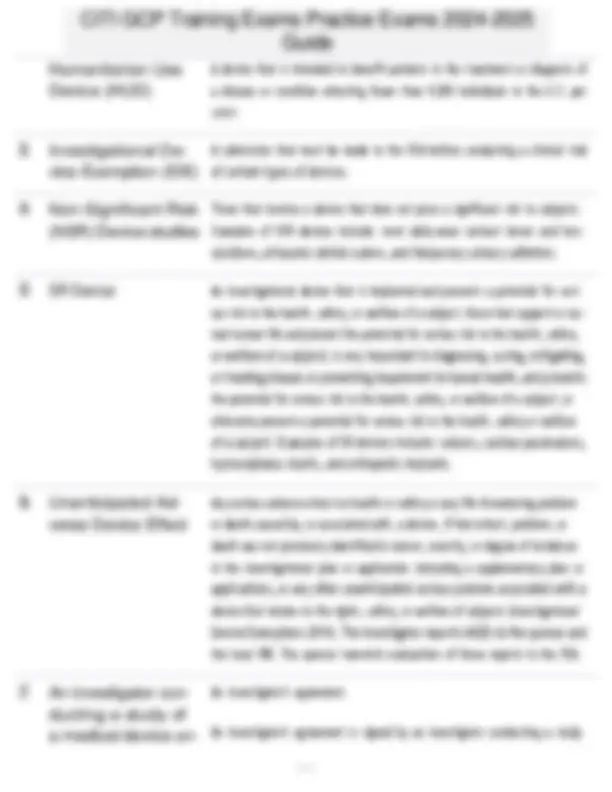
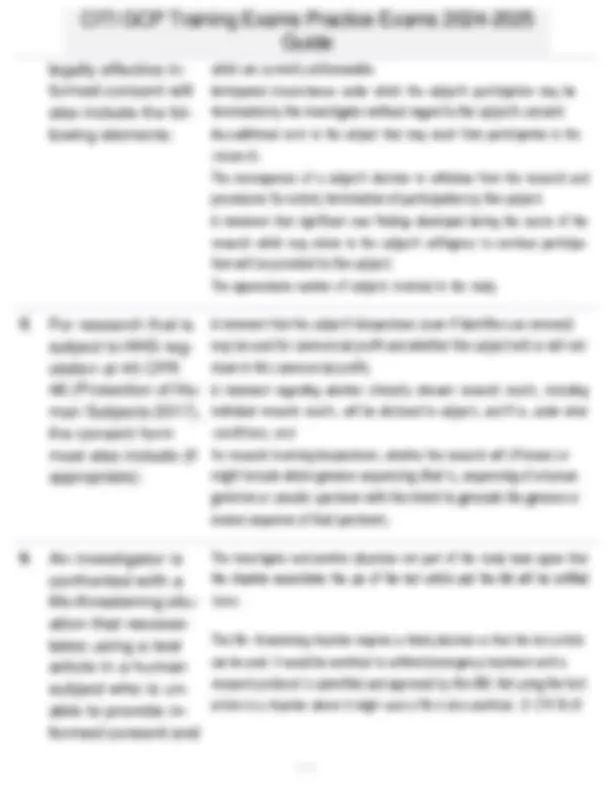
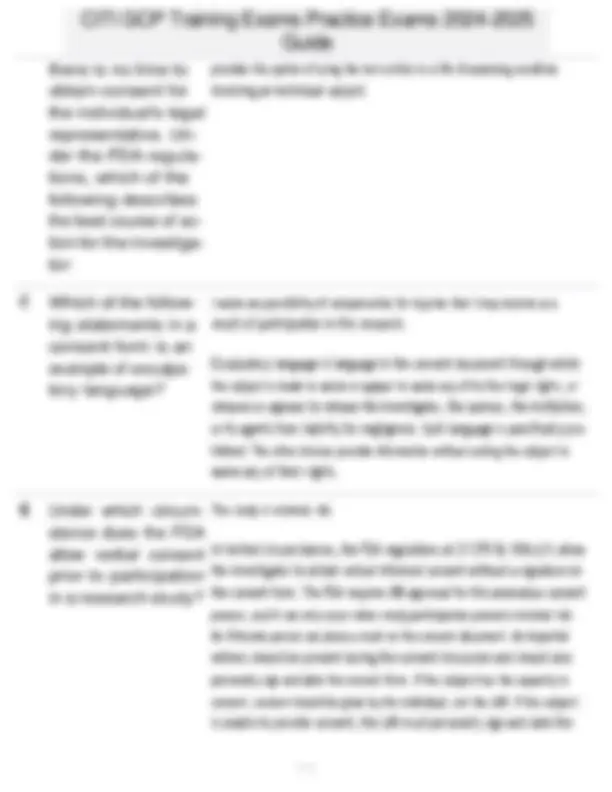
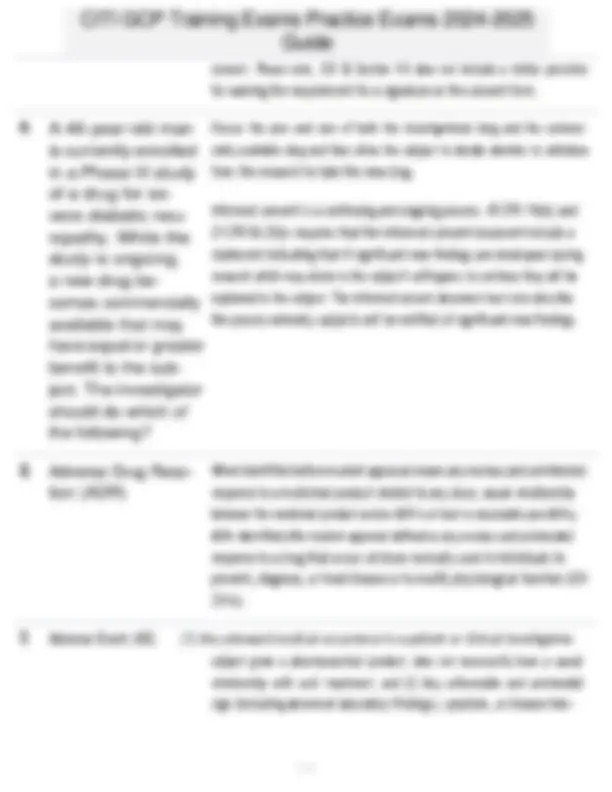
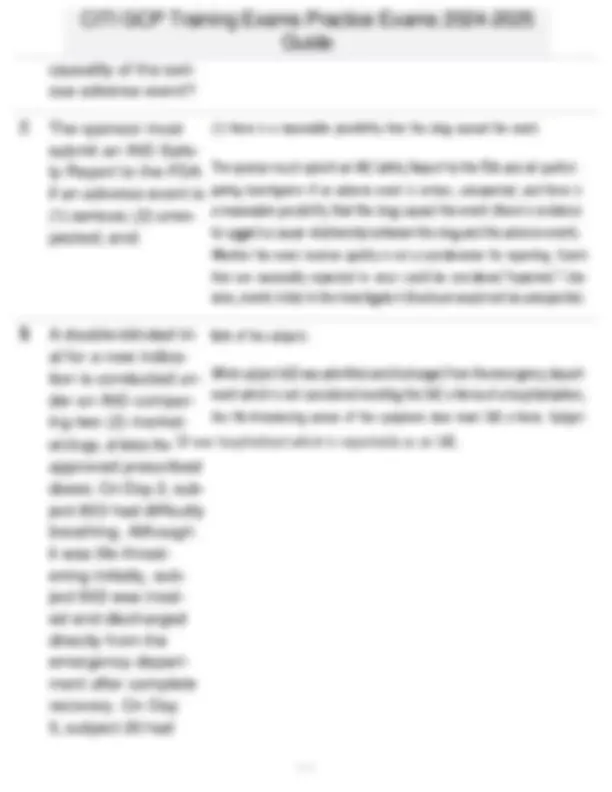
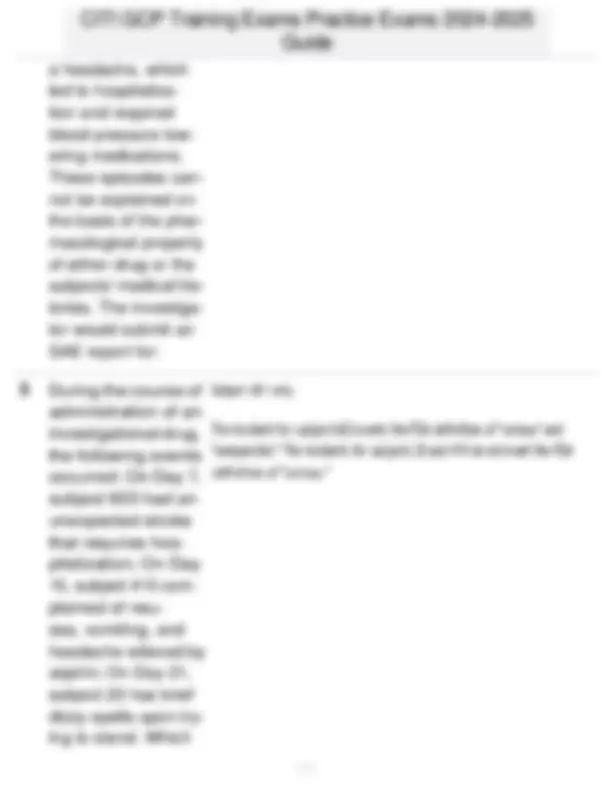
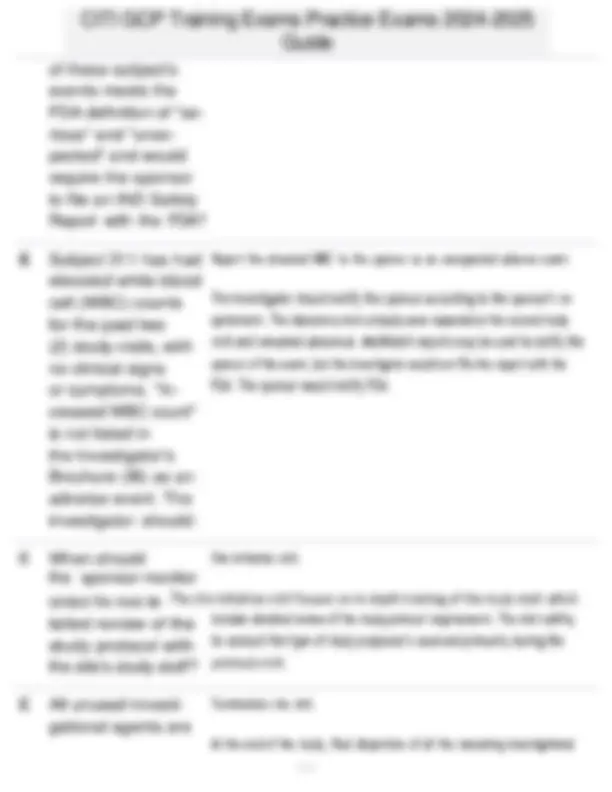
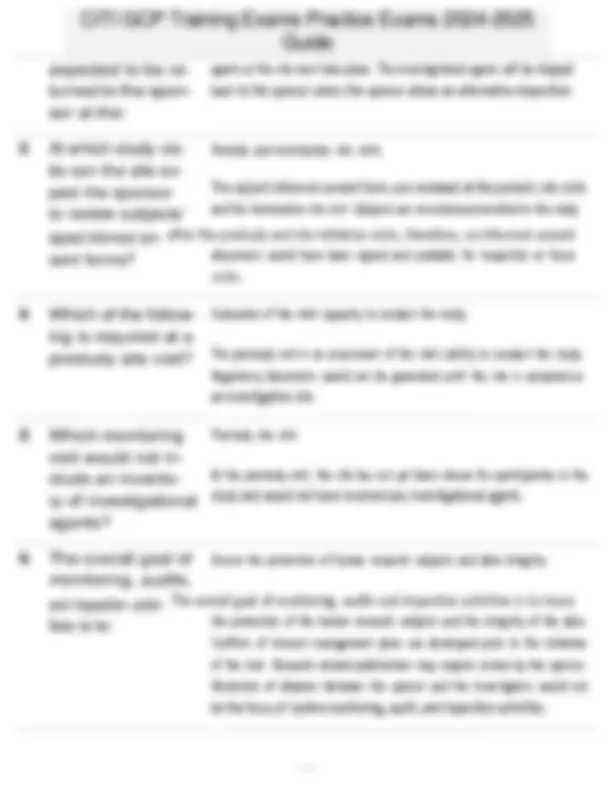
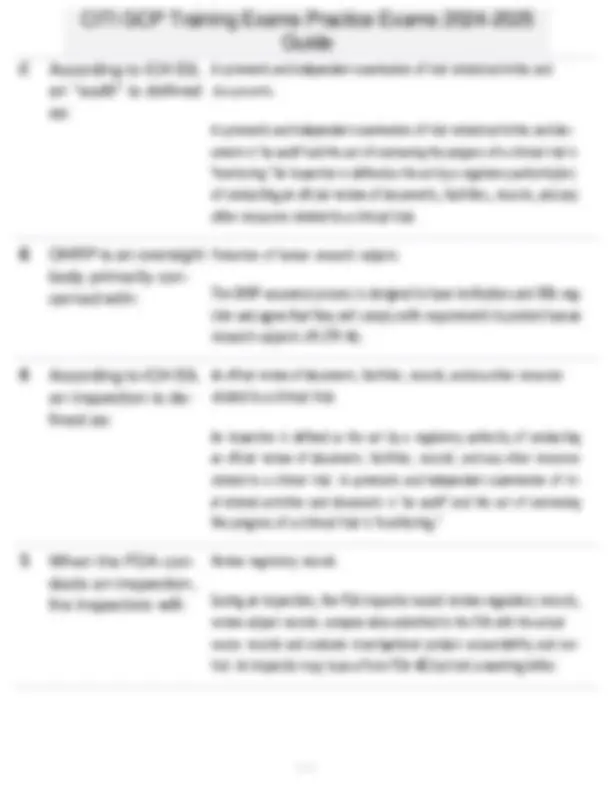


Study with the several resources on Docsity

Earn points by helping other students or get them with a premium plan


Prepare for your exams
Study with the several resources on Docsity

Earn points to download
Earn points by helping other students or get them with a premium plan
Community
Ask the community for help and clear up your study doubts
Discover the best universities in your country according to Docsity users
Free resources
Download our free guides on studying techniques, anxiety management strategies, and thesis advice from Docsity tutors
CITI GCP Training Exams Practice Exams 2024-2025 Guide
Typology: Exams
1 / 22

This page cannot be seen from the preview
Don't miss anything!















subject's medical records.
ICH (2016) E6 Section 4.8.10(n) states that the informed consent should indicate that "the monitor(s), the auditor(s), the IRB/IEC, and the regulatory authority(ies) will be granted direct access to the subject's original medical records for verification of clinical trial procedures and/or data, without violat- ing the confidentiality of the subject, to the extent permitted by the applicable laws and regulations and that, by signing a written informed consent form, the subject or the subject's legally acceptable representative is authorizing such access." The FDA regulations at 21 CFR 50.25(a)(5) (Protection of Human Subjects
It is a FDA guidance.
After the ICH E6 guideline was finalized, several countries adopted it as law. In the United States, however, the FDA adopted the ICH E6 only as guidance. Therefore, the ICH E6 guideline does not have the force of law in the United States and is not a regulation. In the Federal Register notice, FDA stated that the ICH E6 guideline "does not create or confer any rights for or on any person and does not operate to bind FDA or the public. An alternative
approach may be used if such approach satisfies the requirements of the applicable statutes, regulations, or both" (HHS and FDA 1997, 25692).
Therefore, compliance is voluntary, but as with any published FDA guidance, compliance is considered part of good clinical practice.
(LARs) to receive either a signed or unsigned copy.
The FDA regulations allow subjects to receive either a signed or unsigned copy. ICH E6 Section 4.8.11 requires that the subject or the legally acceptable representative (LAR) receive a copy of the signed and dated written informed consent form. The FDA (1998) regulations allow subjects to receive either a signed or unsigned copy. To be in compliance with ICH E6 guideline, the investigator should include a statement in the consent form that the subject will receive a signed and dated copy of the consent form. Persons obtaining consent must then ensure that this procedure is followed.
Identification of study risks to determine which may safely be omitted from continual monitoring.
ICH (2016) E6 Section 5.0.4 states that the sponsor should decide which risks to reduce and/or which risks to accept. The approach used to reduce risk to an acceptable level should be proportionate to the significance of the risk. Risk reduction activities may be incorporated in protocol design and implementation, monitoring plans, and agreements. Routine scheduled audits of study documentation whether on-site or remote are not considered fully responsive to the need for continuous monitoring of data under a proactive risk-based approach.
A compilation of the clinical and nonclinical data on the investigational prod- ucts which is relevant to the study of the investigational products in human subjects. (ICH GCP E6 1.36)
In some instances, the manufacturer of an IND might already have an active IND for the drug being studied by a sponsor-investigator. In these instances, the manufacturer may agree to provide a letter of cross-reference that enables the sponsor-investigator to reference the following technical information from the manufacturer's IND in the sponsor-investigator IND: Chemistry, manufacturing, and controls (CMC) information Pharmacology and toxicology information Previous human experience with the drug This cross-referencing between INDs prevents the unnecessary submission of duplicate information to the FDA and lessens the burden on the spon- sor-investigator. However, if the drug product or process is ditterent from that of the drug information being cross-referenced from the manufacturer's IND, a CMC section detailing those ditterent processes must be included in the sponsor-investigator IND.
The study is not intended to be reported to FDA to support a new indication or support a labeling change.
The number of subjects in a study is not a consideration for IND exemption. Any study that significantly increases risk to subjects or invokes an exception from informed consent for emergency research (21 CFR 50.24) does not meet one of the criterion for an IND exemption. Investigations that are not intended to be reported to FDA do qualify as meeting one of the six required conditions for an IND exemption.
IND report
The sponsor-investigator is required to keep the FDA updated through IND
Which of the follow- ing is an investiga- tor's commitment to the sponsor?
Submit a new Form FDA 1572 to the sponsor as needed.
The investigator must submit a new Form FDA 1572 to the sponsor when an investigator is participating in a new protocol that has been added to the IND or when a new investigator is added to the study. The IRB, not the sponsor, provides ongoing approval for study continuation at the site. The investigator submits the financial disclosure document to the sponsor and the sponsor submits financial disclosure information to FDA. Study record retention is two (2) years after drug approval, disapproval, or study termination.
Sponsor.
The investigator initially reports all adverse events to the sponsor The sponsor transmits reports to the FDA. Local institutions may require additional report- ing.
Sponsor.
The investigator provides the sponsor with a completed form for reporting financial interests to the FDA. The sponsor is responsible for providing the FDA with this information. This includes potential financial interests in the sponsor's company or financial interests that might be influenced positively or negatively by the outcome of the clinical investigation.
Conduct or supervise the investigation personally.
All investigators agree to personally conduct or supervise the investigation when they sign the Form FDA 1572. They must report adverse events to the sponsor, not the FDA. Records must be retained for two (2) years after drug approval, disapproval, or study termination. Maintaining a contract is not a requirement.
Form FDA 1572, Statement of Investi- gator, is legally bind- ing between the in- vestigator and the:
The investigator signs the Form FDA 1572 and provides the signed form to the sponsor for filing with the FDA. By signing this form, the investigator agrees to conduct the study according to the protocol and FDA regulations.
A new drug, antibiotic drug, or biological drug that is used in a clinical investigation. The term also includes a biological product that is used in vitro for diagnostic purposes.
Any unapproved drug, medical device, or biologic undergoing clinical trials to provide evidence to regulatory authorities that the product is safe and eflcacious.
Drug shipping and disposition records.
Drug accountability includes tracking of the receipt and return/destruction of the investigational product and dispensing/administration records showing
Humanitarian Use Device (HUD)
A device that is intended to benefit patients in the treatment or diagnosis of a disease or condition attecting fewer than 8,000 individuals in the U.S. per year.
A submission that must be made to the FDA before conducting a clinical trial of certain types of devices.
Those that involve a device that does not pose a significant risk to subjects. Examples of NSR devices include: most daily-wear contact lenses and lens solutions, ultrasonic dental scalers, and temporary urinary catheters.
Any serious adverse ettect on health or safety or any life-threatening problem or death caused by, or associated with, a device, if that ettect, problem, or death was not previously identified in nature, severity, or degree of incidence in the investigational plan or application (including a supplementary plan or application), or any other unanticipated serious problem associated with a device that relates to the rights, safety, or welfare of subjects (Investigational Device Exemptions 2014). The investigator reports UADEs to the sponsor and the local IRB. The sponsor transmits evaluations of these reports to the FDA.
An investigator's agreement.
An investigator's agreement is signed by an investigator conducting a study
der an IDE is required of a medical device under an IDE. There is no standard FDA form for investiga- to complete and sign which of the follow- ing?
tor agreements. The other choices are not specified in investigational device regulations.
When the new device to be marketed is substantially similar (equivalent) to one already on the market.
A 510(k) Premarket Notification is submitted when a manufacturer wishes to market a qualified medical device in the U.S. without conducting clinical trials. To do so, the manufacturer must demonstrate to FDA that the device is equivalent to one already marketed. An IDE must be submitted when clinical trials of investigational devices are needed to determine the safety and ettectiveness of a new device or when studying substantial modifications to or new intended uses for devices already on the market. A Premarket Approval (PMA) might be submitted for the FDA to evaluate the results of a completed clinical trial of a Class III device.
Sponsor.
The investigator reports UADEs to the sponsor and the local IRB. The sponsor transmits evaluations of these reports to the FDA.
Consent must be legally ettective. The language used (written and oral) to obtain consent must be under- standable to the subject or the subject's LAR (and impartial witness, when applicable). Consent must be obtained under circumstances that allow the subject (or the subject's LAR) suflcient time to decide whether or not participate. Consent must be obtained without undue influence or coercion.
legally effective in- formed consent will also include the fol- lowing elements:
which are currently unforeseeable. Anticipated circumstances under which the subject's participation may be terminated by the investigator without regard to the subject's consent. Any additional costs to the subject that may result from participation in the research. The consequences of a subject's decision to withdraw from the research and procedures for orderly termination of participation by the subject. A statement that significant new findings developed during the course of the research which may relate to the subject's willingness to continue participa- tion will be provided to the subject. The approximate number of subjects involved in the study.
A statement that the subject's biospecimens (even if identifiers are removed) may be used for commercial profit and whether the subject will or will not share in this commercial profit; A statement regarding whether clinically relevant research results, including individual research results, will be disclosed to subjects, and if so, under what conditions; and For research involving biospecimens, whether the research will (if known) or might include whole genome sequencing (that is, sequencing of a human germline or somatic specimen with the intent to generate the genome or exome sequence of that specimen).
The investigator and another physician not part of the study team agree that the situation necessitates the use of the test article and the IRB will be notified later.
The life- threatening situation requires a timely decision so that the test article can be used. It would be unethical to withhold emergency treatment until a research protocol is submitted and approved by the IRB. Not using the test article in a situation where it might save a life is also unethical. 21 CFR 50.
there is no time to obtain consent for the individual's legal representative. Un- der the FDA regula- tions, which of the following describes the best course of ac- tion for the investiga- tor:
provides the option of using the test article in a life-threatening condition involving an individual subject.
I waive any possibility of compensation for injuries that I may receive as a result of participation in this research.
Exculpatory language is language in the consent document through which the subject is made to waive or appear to waive any of his/her legal rights, or releases or appears to release the investigator, the sponsor, the institution, or its agents from liability for negligence. Such language is specifically pro- hibited. The other choices provide information without asking the subject to waive any of their rights.
The study is minimal risk.
In limited circumstances, the FDA regulations at 21 CFR 56.109(c)(1) allow the investigator to obtain verbal informed consent without a signature on the consent form. The FDA requires IRB approval for this anomalous consent process, and it can only occur when study participation presents minimal risk. An illiterate person can place a mark on the consent document. An impartial witness should be present during the consent discussion and should also personally sign and date the consent form. If the subject has the capacity to consent, consent should be given by the individual, not the LAR. If the subject is unable to provide consent, the LAR must personally sign and date the
porally associated with the use of a medicinal (investigational) product; not necessarily related to the product (ICH 2016).
Adverse events where the subject outcome is death, life-threatening (sub- stantial risk of dying at the time of the adverse event or continued use might have resulted in death), inpatient hospitalization or an extension of an exist- ing hospitalization, disability or permanent damage (substantial disruption of the ability to conduct normal life functions), congenital anomaly/birth de- fect, or required intervention to prevent permanent impairment, or otherwise serious (does not fit other outcomes, but the event may jeopardize the patient and may require medical or surgical intervention to prevent one of the other outcomes (21 CFR 312 [Investigational New Drug Application 2014]).
The timing of the event in relation to administration of the investigational agent.
Whether or not an event qualifies as serious is a regulatory determination and would not be a consideration in assessing the causality of the event. The timing of the event in relation to the administration of the investigational agent should be considered in determining the causality of the event.
The sponsor of the research should specify what is appropriate to record for the particular protocol, so that the data are consistent across research sites. Accurate reporting is essential for subject safety. Adverse event report- ing might attect the informed consent document, but is unlikely to change recruitment materials.
Report adverse events of both a broken wrist and a mild concussion.
The broken wrist and mild concussion are changes from the subject's base- line and are unexpected and untoward medical occurrences and therefore
hicle crash. The sub- ject sustained a bro- ken wrist and mild concussion. The sub- ject was treated and released from the emergency depart- ment. What should the investigator do when learning of the crash?
reportable as adverse events. The motor vehicle crash is the cause of the adverse events, not the adverse event itself.
Principal Investigator.
Determining the relationship of the investigational agent to an adverse event requires medical decision making and expertise. The person making this determination should be medically qualified to do so. The Principal Investi- gator of the Phase I study is responsible for assessing and reporting adverse events.
a headache, which led to hospitaliza- tion and required blood pressure low- ering medications. These episodes can- not be explained on the basis of the phar- macological property of either drug or the subjects' medical his- tories. The investiga- tor would submit an SAE report for:
Subject 603 only.
The incident for subject 603 meets the FDA definition of "serious" and "unexpected." The incidents for subjects 20 and 415 do not meet the FDA definition of "serious."
of these subject's events meets the FDA definition of "se- rious" and "unex- pected" and would require the sponsor to file an IND Safety Report with the FDA?
Report the elevated WBC to the sponsor as an unexpected adverse event.
The investigator should notify the sponsor according to the sponsor's re- quirements. The laboratory tests already were repeated at the second study visit and remained abnormal. MedWatch reports may be used to notify the sponsor of the event, but the investigator would not file the report with the FDA. The sponsor would notify FDA.
Site initiation visit.
conduct the most de- The^ site^ initiation visit focuses on^ in-depth^ training of the study^ statt which tailed review of the study protocol with the site's study staff?
includes detailed review of the study protocol requirements. The site's ability to conduct the type of study proposed is assessed primarily during the prestudy visit.
Termination site visit.
At the end of the study, final disposition of all the remaining investigational